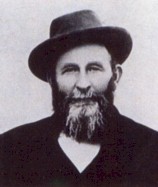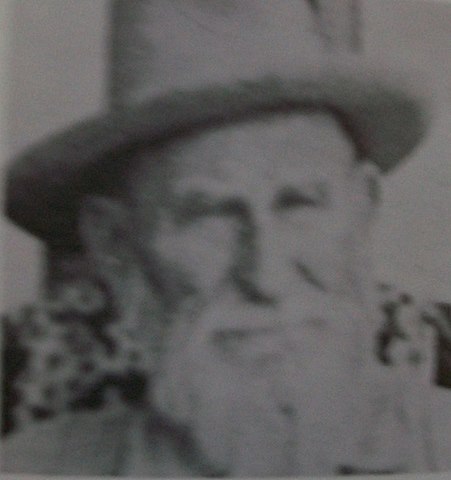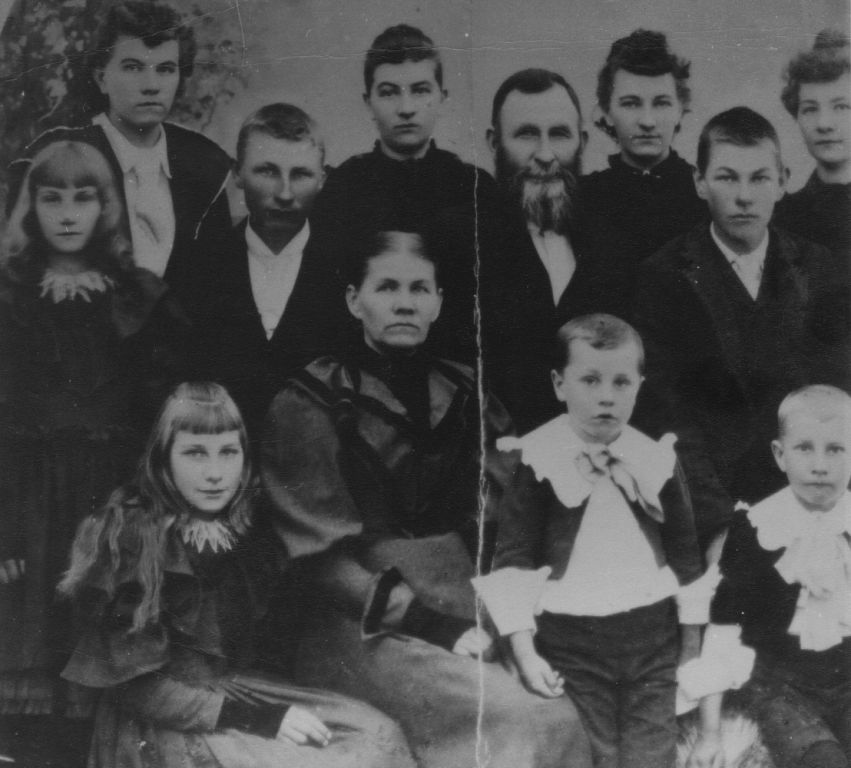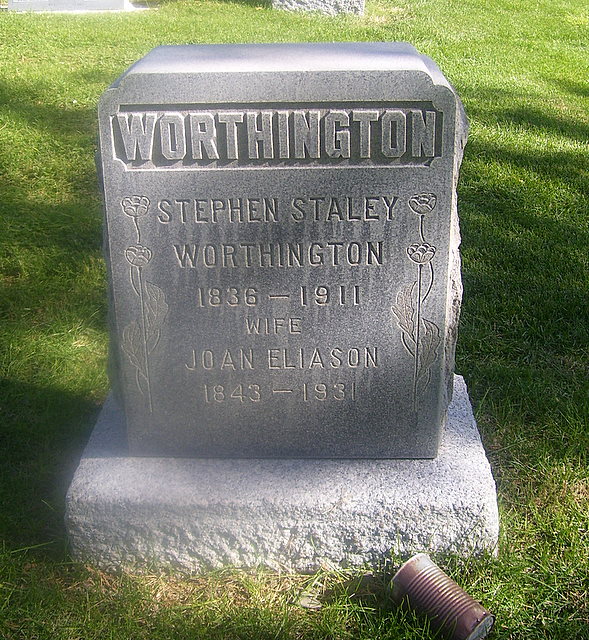by Nona Worthington Shibley
Stephen Staley Worthington was born April 3, 1836, in, Beaver County, Pennsylvania. The family lived near the Ohio River about 20 miles west of Pittsburgh. (This date is easily remembered as it is the same day the Kirtland Temple was dedicated and the visitation of Elijah, Moses, the Savior and others occurred.) He was the fifth child of James and Rachel Staley Worthington
He was born the same year his parents joined The Church of Jesus Christ of Latter-day Saints. The family lived in Nauvoo, Illinois, at the time the Prophet Joseph Smith and Hyrum were martyred. Stephen, eight-years-old at the time, stated that he saw the bodies of Joseph and Hyrum lying covered with buffalo robes.
Stephen came to Utah as a boy in his teens. Soon after coming to Utah, he, in company with some other young men, went to California after they heard of the gold discovery there. He remained in California for about ten years to acquire some rich farming land in the famous Sacramento Valley. This was at a place called Elk Grove. He had a very fine vineyard and orchard. About 1862 or so he returned to Utah and lived at Ibapah where his parents had been called by President Brigham Young to work among the Indians. A few years later, he settled in Grantsville, Utah.
The story is told that on one occasion the boys had some cattle in the corral. The boys staged a "rodeo" while their parents were away and Stephen broke his arm. When his parents returned home, they found Stephen with his arm dangling, the bones being broken and just the skin holding it together. His mother set the bones in place and put splints on it. It soon healed and Stephen never mentioned this arm as ever causing any trouble in later years.
Stephen married Johanna Eliason, December 30, 1867. The ceremony was performed by Bishop John Rowberry. This marriage was held at the old Fish and Dairy Building near the Mill Pond. Eleven children were born to them, ten grew to maturity and six are still living (November 1954). Their names were Johanna Cecelia, Sarah Ann, Rachel, Birdie, Julia, Phoebe, Stephen Hampton, Fred, who died when ten-years-old, James, Charles and Samuel.
Stephen engaged in the freighting business for a number of years. He had several men working with him and they hauled freight from Salt Lake City and vicinity to all points west, even to California. He hauled freight. He hauled freight to the famous Comstock Mine at Virginia City, Nevada, and also to the Dolly Vardon Mine, which was another well known mine. Freighting was a very dangerous occupation because there were so many bandits and robbers always lying in visit for the wagon trains. On one occasion, he was hauling a load of potatoes from Salt Lake City to Nevada when the wagon party was held-up by bandits. The driver of the wagon in front of Stephen was shot and robbed. The bandit came back toward Stephen's wagon. Steve held a muzzle loader gun on him while the Indian who was helping him dug down into the load of potatoes to get some more powder shot. Stephen loaded his gun and shot at the robber as he fled. Steve later remarked he never heard a person yell so loud and run so fast. On this occasion, Stephen had $2,200 on his person. Another time he had $1,800 on him when an attempt was made to rob him, but he never was robbed by any of the desert bandits. On one occasion another freighting company was robbed at Spruce, Nevada. The men were tied to the wheels of the wagon with the horses still hitched to it. One of the men succeeded in getting loose and he untied the others before the horses ran away.
Freighting in those days seemed to have more than its share of work and toil, as many times the wagon became stuck in the desert mud and mired down. Frequently the contents of the wagon would have to be unloaded and several spans of miles and horses hitched on to the stuck wagon to pull it free of the sticky alkali desert mud. Sometimes the wagons would lose a wheel or the horses and mules got sick which would delay the trip. Steve also drove for the Pony Express from Salt Lake City to points west. These stories point out the danger of hauling many of the necessities of life across the hazards of the desert and mountains of the West.
One time a group of Indians wanted to go to California so Steve and others permitted them to go along with the wagon train. After they had been out several days, the Indians became restless and wanted to stop. That night the Indians stole away with the oxen. The Indians had found the hoof of a horse and used it to make a hoof print to cover the oxen hoof prints thus making it hard to follow. The oxen were found a day later, but no trace was found of the Indians. This episode caused two days delay on that particular trip.
Stephen was also engaged in some farming and stock raising at Grantsville. He used his land rights and got the land where Jack Worthington now lives. Here he built a comfortable home and the family took care of things while he was away on the freighting trips. Stephen liked to have fine horses and cattle and took pride in improving his herd. One time he purchased some cattle from Texas. These cattle were branded with a T (tee square). He continued to use this brand and it is still used by his son Charles. Another time, Black Angus cattle were purchased. With these cattle a Scotch Hyland cow was included. It had very long horns. The cow was bred to a native buffalo and she bore a calf that looked like a buffalo. It had a dark red color. This calf was turned out on the range and was never seen again.
Stephen Worthington played an active part in the development of rail transportation in this area. He and Riley Judd had a contract to build a section of the railroad near Camp Floyd and Fairview, Utah. He also helped in the survey of the right-of-way for the Western Pacific Railroad between Salt Lake City and Knolls, Utah. He worked with Heuton Dunyon and a Mr. House, a civil engineer employed by the railroad company to survey the most feasible route west from Salt Lake to the Pacific Coast. These men used signal fires on top of the hills to signal each other in a similar way the Indians used smoke signals.
Stephen was always adventurous and interested in seeing places that others had not seen. He visited and explored every island on the Great Salt Lake. In the year 1902, Steve, Don Cooley and Gustave Anderson took some cattle to winter on Carrington Island. The lake was at a very low level at that time. They lost several head of cattle because of the sticky deep mud.
In the year 1886, Stephen and his oldest daughter, Cecelia, went to California for the G.A.R. Encampment (Grand Army of the Republic). Others who went from Grantsville were Richard and Jenny Rydalch, Mamie Knowlton and Mary Alice Wrathall. They had a very interesting trip. They went to Catalina Island and saw the ocean fish in a glass-bottomed boat. They also visited the place where Stephen lived some 25 years before.
In 1897, the year of the Utah Jubilee, Stephen was offered $150 by the Jubilee Committee if he could bring in a complete wagon remaining from the ill-fated Donner Party. He made several attempts but was unable to get a complete wagon. It was reported that he obtained three wheels and a running gear, an ox yoke, a U.S. Flag, some square cut nails and cooking utensils. These articles were placed in the Museum in Salt Lake City. His son, Stephen Hampton, known as Hamp, was with him on this attempt.
Stephen went to California again in 1908 as a guest of the Western Pacific Railroad for his services in surveying for the right-of-way. He was accompanied on this trip by Wilford (Bub) Hudson.
The family home was destroyed by fire March 17, 1907, and all the family belongings were burned except the piano. Many valuable records and items of interest were also lost. Stephen moved to a two-room house from town to the farm and the family lived in this small house while a home was built on the foundation of the old home. This is the home of Jack Worthington at the present time (1954)
Stephen passed away on August 18, 1911. The Indians came from far and near to attend his funeral. He was always a true friend to the Indians. His wife, Johanna, died March 15, 1931. This ended a chapter of a colorful and useful pair who were truly pioneers of the West.
by Nona Worthington Shibley
Stephen Staley Worthington was born April 3, 1836, in, Beaver County, Pennsylvania. The family lived near the Ohio River about 20 miles west of Pittsburgh. (This date is easily remembered as it is the same day the Kirtland Temple was dedicated and the visitation of Elijah, Moses, the Savior and others occurred.) He was the fifth child of James and Rachel Staley Worthington
He was born the same year his parents joined The Church of Jesus Christ of Latter-day Saints. The family lived in Nauvoo, Illinois, at the time the Prophet Joseph Smith and Hyrum were martyred. Stephen, eight-years-old at the time, stated that he saw the bodies of Joseph and Hyrum lying covered with buffalo robes.
Stephen came to Utah as a boy in his teens. Soon after coming to Utah, he, in company with some other young men, went to California after they heard of the gold discovery there. He remained in California for about ten years to acquire some rich farming land in the famous Sacramento Valley. This was at a place called Elk Grove. He had a very fine vineyard and orchard. About 1862 or so he returned to Utah and lived at Ibapah where his parents had been called by President Brigham Young to work among the Indians. A few years later, he settled in Grantsville, Utah.
The story is told that on one occasion the boys had some cattle in the corral. The boys staged a "rodeo" while their parents were away and Stephen broke his arm. When his parents returned home, they found Stephen with his arm dangling, the bones being broken and just the skin holding it together. His mother set the bones in place and put splints on it. It soon healed and Stephen never mentioned this arm as ever causing any trouble in later years.
Stephen married Johanna Eliason, December 30, 1867. The ceremony was performed by Bishop John Rowberry. This marriage was held at the old Fish and Dairy Building near the Mill Pond. Eleven children were born to them, ten grew to maturity and six are still living (November 1954). Their names were Johanna Cecelia, Sarah Ann, Rachel, Birdie, Julia, Phoebe, Stephen Hampton, Fred, who died when ten-years-old, James, Charles and Samuel.
Stephen engaged in the freighting business for a number of years. He had several men working with him and they hauled freight from Salt Lake City and vicinity to all points west, even to California. He hauled freight. He hauled freight to the famous Comstock Mine at Virginia City, Nevada, and also to the Dolly Vardon Mine, which was another well known mine. Freighting was a very dangerous occupation because there were so many bandits and robbers always lying in visit for the wagon trains. On one occasion, he was hauling a load of potatoes from Salt Lake City to Nevada when the wagon party was held-up by bandits. The driver of the wagon in front of Stephen was shot and robbed. The bandit came back toward Stephen's wagon. Steve held a muzzle loader gun on him while the Indian who was helping him dug down into the load of potatoes to get some more powder shot. Stephen loaded his gun and shot at the robber as he fled. Steve later remarked he never heard a person yell so loud and run so fast. On this occasion, Stephen had $2,200 on his person. Another time he had $1,800 on him when an attempt was made to rob him, but he never was robbed by any of the desert bandits. On one occasion another freighting company was robbed at Spruce, Nevada. The men were tied to the wheels of the wagon with the horses still hitched to it. One of the men succeeded in getting loose and he untied the others before the horses ran away.
Freighting in those days seemed to have more than its share of work and toil, as many times the wagon became stuck in the desert mud and mired down. Frequently the contents of the wagon would have to be unloaded and several spans of miles and horses hitched on to the stuck wagon to pull it free of the sticky alkali desert mud. Sometimes the wagons would lose a wheel or the horses and mules got sick which would delay the trip. Steve also drove for the Pony Express from Salt Lake City to points west. These stories point out the danger of hauling many of the necessities of life across the hazards of the desert and mountains of the West.
One time a group of Indians wanted to go to California so Steve and others permitted them to go along with the wagon train. After they had been out several days, the Indians became restless and wanted to stop. That night the Indians stole away with the oxen. The Indians had found the hoof of a horse and used it to make a hoof print to cover the oxen hoof prints thus making it hard to follow. The oxen were found a day later, but no trace was found of the Indians. This episode caused two days delay on that particular trip.
Stephen was also engaged in some farming and stock raising at Grantsville. He used his land rights and got the land where Jack Worthington now lives. Here he built a comfortable home and the family took care of things while he was away on the freighting trips. Stephen liked to have fine horses and cattle and took pride in improving his herd. One time he purchased some cattle from Texas. These cattle were branded with a T (tee square). He continued to use this brand and it is still used by his son Charles. Another time, Black Angus cattle were purchased. With these cattle a Scotch Hyland cow was included. It had very long horns. The cow was bred to a native buffalo and she bore a calf that looked like a buffalo. It had a dark red color. This calf was turned out on the range and was never seen again.
Stephen Worthington played an active part in the development of rail transportation in this area. He and Riley Judd had a contract to build a section of the railroad near Camp Floyd and Fairview, Utah. He also helped in the survey of the right-of-way for the Western Pacific Railroad between Salt Lake City and Knolls, Utah. He worked with Heuton Dunyon and a Mr. House, a civil engineer employed by the railroad company to survey the most feasible route west from Salt Lake to the Pacific Coast. These men used signal fires on top of the hills to signal each other in a similar way the Indians used smoke signals.
Stephen was always adventurous and interested in seeing places that others had not seen. He visited and explored every island on the Great Salt Lake. In the year 1902, Steve, Don Cooley and Gustave Anderson took some cattle to winter on Carrington Island. The lake was at a very low level at that time. They lost several head of cattle because of the sticky deep mud.
In the year 1886, Stephen and his oldest daughter, Cecelia, went to California for the G.A.R. Encampment (Grand Army of the Republic). Others who went from Grantsville were Richard and Jenny Rydalch, Mamie Knowlton and Mary Alice Wrathall. They had a very interesting trip. They went to Catalina Island and saw the ocean fish in a glass-bottomed boat. They also visited the place where Stephen lived some 25 years before.
In 1897, the year of the Utah Jubilee, Stephen was offered $150 by the Jubilee Committee if he could bring in a complete wagon remaining from the ill-fated Donner Party. He made several attempts but was unable to get a complete wagon. It was reported that he obtained three wheels and a running gear, an ox yoke, a U.S. Flag, some square cut nails and cooking utensils. These articles were placed in the Museum in Salt Lake City. His son, Stephen Hampton, known as Hamp, was with him on this attempt.
Stephen went to California again in 1908 as a guest of the Western Pacific Railroad for his services in surveying for the right-of-way. He was accompanied on this trip by Wilford (Bub) Hudson.
The family home was destroyed by fire March 17, 1907, and all the family belongings were burned except the piano. Many valuable records and items of interest were also lost. Stephen moved to a two-room house from town to the farm and the family lived in this small house while a home was built on the foundation of the old home. This is the home of Jack Worthington at the present time (1954)
Stephen passed away on August 18, 1911. The Indians came from far and near to attend his funeral. He was always a true friend to the Indians. His wife, Johanna, died March 15, 1931. This ended a chapter of a colorful and useful pair who were truly pioneers of the West.
Family Members
-
![]()
Cecilia Worthington McHattie
1868–1944
-
![]()
Sarah Worthington Wagner
1870–1961
-
![]()
Rachel Augusta Worthington Anderson
1872–1936
-
![]()
Birdie Eliza Worthington Anderson
1874–1956
-
![]()
Stephen Hampton "Hamp" Worthington
1876–1948
-
![]()
James Stanley Worthington
1878–1960
-
![]()
Frederick G Worthington
1880–1890
-
![]()
Phoebe Staley Worthington Bills
1883–1973
-
![]()
Charles Homer Worthington
1885–1972
-
![]()
Samuel Hilton Worthington
1888–1971
Sponsored by Ancestry
Advertisement
Explore more
Sponsored by Ancestry
Advertisement






















